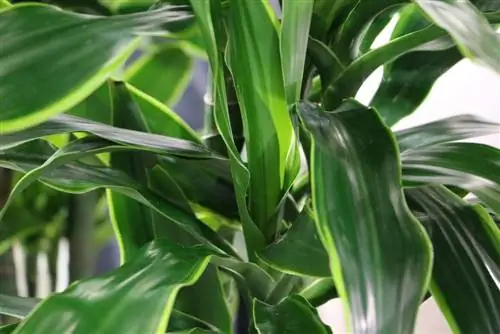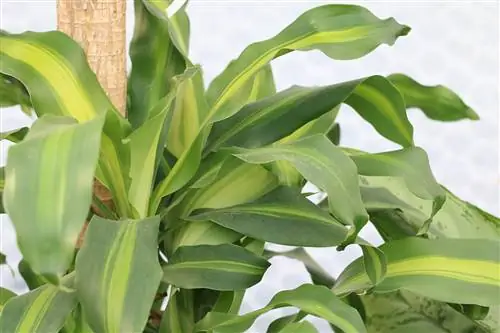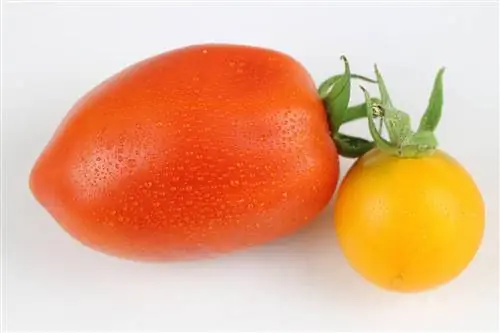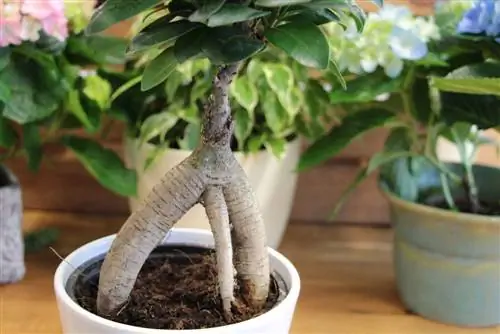- Author admin [email protected].
- Public 2023-12-17 03:39.
- Last modified 2025-01-24 12:45.
Can you imagine an apartment, an office, a restaurant or a shop without plants? You will hardly be able to do this, because we see houseplants everywhere. The reason for this is not only their decorative effect, but also their positive influence on the indoor climate. The green plants are air humidifiers and pollutant filters at the same time. We introduce you to 10 suitable houseplants for residential and commercial spaces.
Multi-talented houseplant
The air quality in enclosed spaces is primarily affected by modern materials such as chipboard, laminate, plastics as well as the volatile chemical compounds in wallpaper, paint, adhesives, etc.impaired. Sensitive people react to these substances with breathing difficulties, headaches and malaise. Even a few green plants can significantly improve air quality.
Carbon dioxide becomes oxygen
Humans need oxygen to live. They absorb it from the air in the room and release carbon dioxide through the air they breathe. Houseplants take the opposite approach. They convert the carbon dioxide from the room air into oxygen as part of photosynthesis.
Green plants can do even more. You
- increase humidity
- catch dust
- neutralize odors
- filter pollutants out of the room air
- reduce the noise
- relax your eyes
Suitable varieties for a good indoor climate
Here you will find a selection of plants for an improved indoor climate, whether in the office or at home.
Aloe Vera
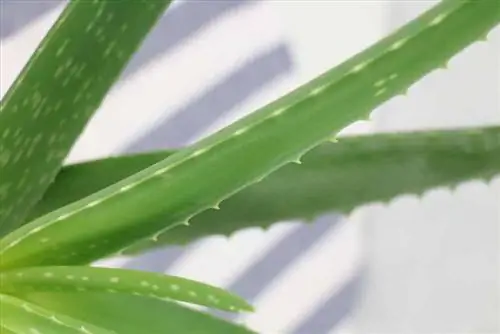
The popular houseplant Aloe Vera has much more to offer than green leaves. It enchants its owner with magnificent flowers in yellow, orange or red. The plant, also known as “Bitterschopf”, is one of the oldest known medicinal plants. It produces a skin-care and he alth-promoting juice in its leaves. With an aloe vera as a houseplant, you benefit from both its decorative effect and its ability to purify the air and reliably filter out pollutants such as formaldehyde.
- Effect: air purification, breakdown of formaldehyde
- Appearance: cactus-like, firm, thick-fleshed, pointed leaves, rosette-shaped growth, leaf edges with thorns
- Size: up to 60 centimeters high depending on the variety
- Light, warmth: bright, sunny, warm
- Moisture: water moderately, the inside of the rosette must not get wet
- Fertilize: fertilize sparingly
- Flowers: attractive yellow, red or orange flowers
- Propagation: via kindles or root runners
- Special feature: perfect bedroom plant
birch fig
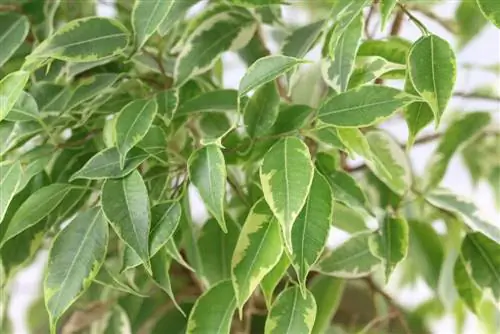
The birch fig (Ficus benjamina) grows along roadsides in warmer regions and is successfully cultivated as a hedge plant. In Germany it is undisputedly one of the most popular green plants. Even though there are more than sixty different species of Ficus, the Ficus benjamina is number 1. People who are allergic to latex should stay away from the Ficus benjamina. Everyone else can enjoy the attractive plant, which also ensures a good indoor climate.
- Effect: air purification, regulation of humidity
- Appearance: upright tree-like growth, smooth green or marbled leaves
- Size: up to 4 meters high
- Light, warmth: partially shaded and warm, avoid direct sun
- Humidity: high humidity required, water weekly and spray with water
- Fertilize: fertilize regularly
- Flowering: blooms very rarely in closed rooms
- Propagation: via head cuttings
- Special feature: slightly toxic, suitable for rooms with bathrooms and winter gardens
bow hemp
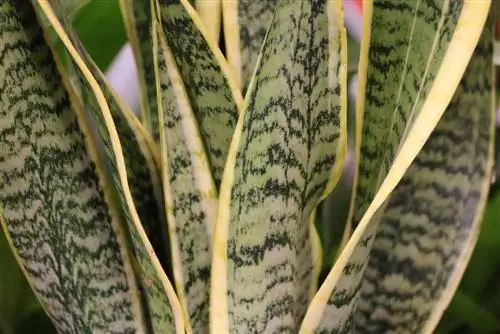
The arched hemp (Sansevieria) is a robust houseplant with the nickname “mother-in-law's tongue”. It used to be in every apartment and every office until other green plants overtook it. Now he's back. Its robustness and he alth-promoting effects have catapulted bow hemp back up the popularity scale. The selection is large, more than 70 different varieties are known. Even if bow hemp does not receive water for several weeks, it will reliably filter and improve the air in the room. Hardly any other plant is so uncomplicated.
- Effect: air purification, air humidification, suitable for asthmatics, breakdown of trichlorethylene and benzene
- Appearance: evergreen, firm pointed leaves, leaf color green with yellow stripes or marbled
- Size: depending on the variety from 10 centimeters to 2 meters high
- Light, warmth: partially shaded to sunny
- Moisture: water moderately
- Fertilize: fertilize sparingly
- Flowers: sweet-smelling, white flowers, very rare
- Propagation: plant division
- Special feature: slightly poisonous
Did you know that bowstrings were once made from the leaves of bow hemp?
Dragon Tree

The dragon tree (Dracaena), is also known as the dragon line. Dracaena means something like “female dragon”. In the areas of origin in Africa and the tropical areas of Asia, the palm-like plant reaches an impressive size. In Germany, the heat-loving dragon tree is one of the most popular houseplants.
- Effect: air purification, reduction of formaldehyde, benzene and trichlorethylene Appearance: palm-like growth, decorative multicolored leaves
- Large: between 1.5 and 2.5 meters high
- Light, warmth: bright
- Moisture: water regularly, avoid waterlogging
- Fertilize: fertilize every two weeks from spring to autumn
- Flowering: rare
- Propagation: top cuttings, ground shoots
- Special feature: slightly poisonous, cats and dogs react sensitively
Efeutute
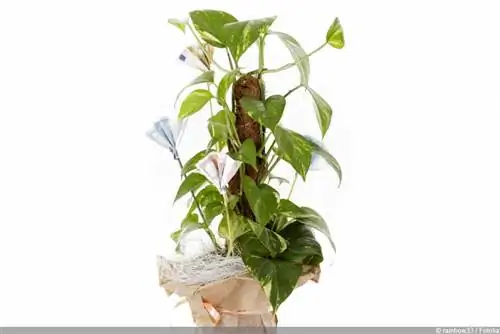
The ivy plant (Epipremnum aureum) belongs to the arum family. It comes from tropical countries. The ivy is the perfect plant for anyone who doesn't have a "green thumb" and still wants magnificent plant decorations. It is uncomplicated, grows well and is very easy to propagate. The plant is one of the ten houseplants with the strongest air purifying properties. It is able to effectively break down formaldehyde and benzene.
- Effect: Air purification
- Appearance: evergreen with completely green, green-white or green-yellow marbled leaves
- Size: climbing or hanging plant with long shoots up to one meter
- Light, warmth: partially shaded, no direct sunlight
- Moisture: water sufficiently, do not let it dry out, hydroponics recommended
- Fertilizing: fertilize sparingly in spring and summer
- Flowering: none
- Propagation: via offshoots and children
- Special feature: poisonous, not suitable near children
Common Ivy

The common ivy (Hedera Helix) ensures an optimal indoor climate. Ivy can be used as a hanging plant or as a climbing plant. Its adhesive roots give the houseplant support in nature or in living and office spaces. By the way, ivy is considered the best choice for the bedroom. The green plant filters more than 90 percent of pollutants such as formaldehyde, trichlorethylene and benzene from the indoor air.
- Effect: regulation of humidity, air purification
- Appearance: evergreen robust leaves
- Size: becomes several meters long, pruning allows the plant to grow bushier
- Light, heat: bright, cool, must not be above the heater
- Moisture: water a lot, immersion bath recommended, lukewarm water
- Fertilize: fertilize every two weeks from spring to summer
- Flowering: no flowers formed indoors
- Propagation: via offshoots
- Special feature: poisonous, use gloves when pruning, frequent spider mite infestation
If you don't want to spend a lot of money on houseplants, ivy is a good choice. You can find it everywhere in nature. Rooting an ivy vine in a glass of water works quite quickly. When enough roots have formed, you can plant the green plant in a flower pot.
Single sheet
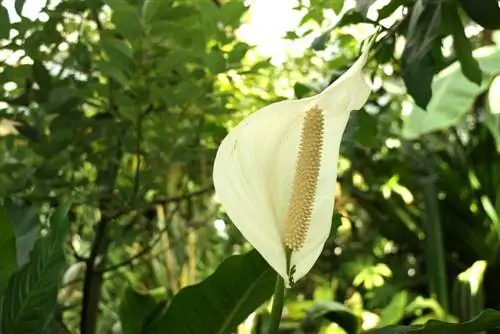
The single leaf (Spathiphyllum wallisii) belongs to the arum family and comes from Brazil. The uncomplicated houseplant is also known as peace lily or leaf flag. The plant with shiny dark green leaves is able to filter formaldehyde from the air. It is ideal for beginners and forgives almost all care mistakes. The bathroom with higher humidity is a suitable location for the leaflet.
- Effect: Air purification
- Appearance: dark green, shiny leaves on long stems, clump-like growth
- Size: 30 to 80 centimeters high
- Light, warmth: shady to partially shaded, no direct sun
- Moisture: water a lot
- Fertilize: fertilize weekly in low doses
- Flowering: beautiful cream-colored flowers from June to September
- Propagation: plant division
- Special feature: like all arum plants, poisonous
Green Lily
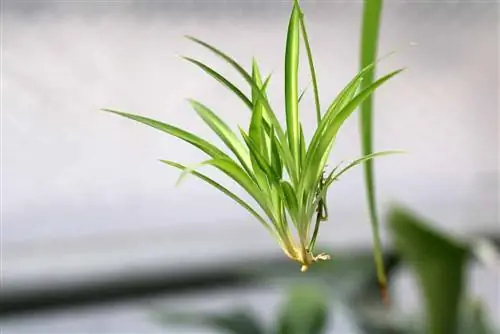
The spider plant (Chlorophytum comosum) is one of the simplest, most uncomplicated and equally decorative plants. It comes from Africa and belongs to the asparagus family. The reason why the spider plant is consistently at the top of the green plant favorites is its ability to improve the air. It manages to filter 90 percent of the pollutants benzene, formaldehyde, carbon dioxide and nitrate from the indoor air.
- Effect: Air purification
- Appearance: evergreen, narrow, long leaves with white stripes Size: about 40 centimeters, many offshoots
- Light, warmth: bright
- Moisture: water regularly, survives long dry phases
- Fertilize: fertilize moderately once a month
- Flowers: Decorative white flowers, resemble small lily flowers
- Propagation: seeds, plant division, children
- Special feature: frequent infestation with spider mites or whiteflies
- Did you know that the spider plant is also called the “official palm” because of its popularity as an office plant?
Sword fern
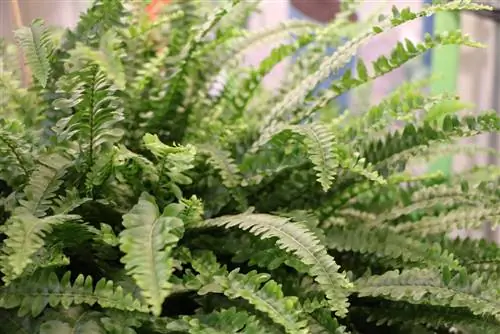
Sword ferns (Nephrolepis) release a lot of oxygen and moisture. They are therefore ideal for rooms with dry heating air and for bedrooms. In its tropical areas of origin, the sword fern grows as an epiphyte on other plants. In bright locations, the sword fern pampers you with a splendor of bright, juicy green leaves. Sword fern filters pollutants such as xylene and formaldehyde from the air.
- Effect: air purification, high oxygen production, balance of humidity
- Appearance: light green fern fronds, dense growth
- Size: hanging plant, leaves up to one meter long
- Light, warmth: warm, bright, no direct sun
- Moisture: water moderately
- Fertilizing: Fertilize once a week in spring and summer
- Flowering: no flower formation
- Propagation: plant division, runners
- Special feature: non-toxic, no danger to pets
Yucca palm
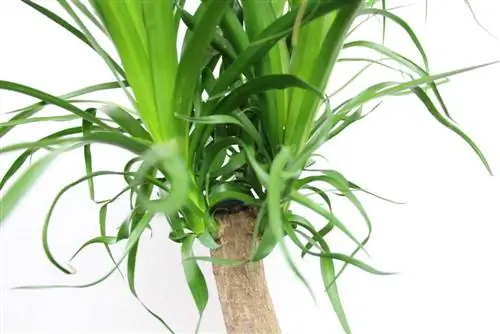
The Yucca palm brings a holiday feeling and a touch of exoticism into your home. It looks like a palm tree, but botanically it belongs to the asparagus family like the spider plant. The yucca is considered undemanding and easy to care for. It thrives well on the balcony or terrace in summer. Its air-improving properties are the reason for its popularity as a houseplant in homes and offices.
- Effect: Air purification
- Appearance: sword-shaped, dark green, robust leaves
- Size: up to three meters high
- Light, warmth: partially shaded
- Moisture: water little, avoid waterlogging
- Fertilize: fertilize every two weeks
- Flowering: no flowering in houseplants
- Propagation: via runners or cut fronds
- Special feature: poisonous, be careful with pets and small children

